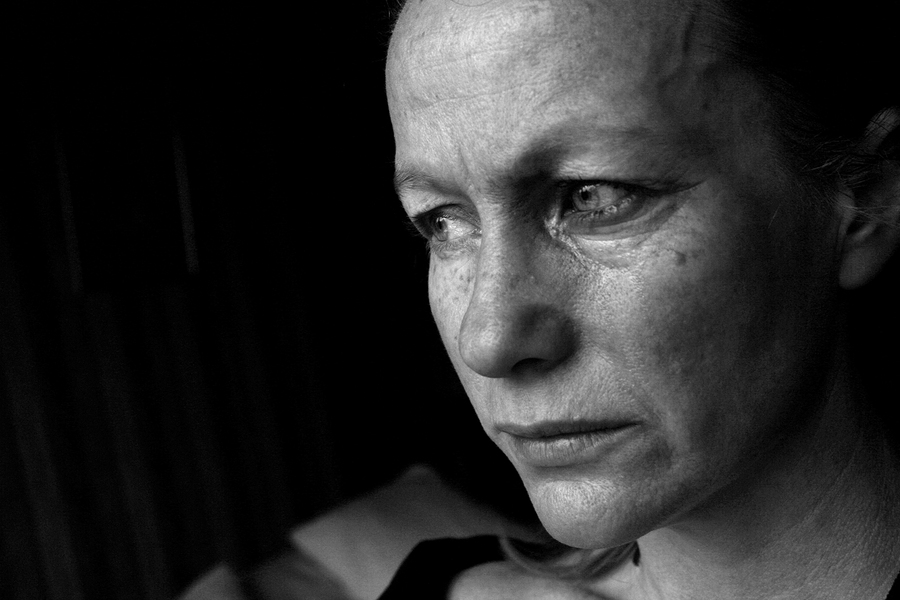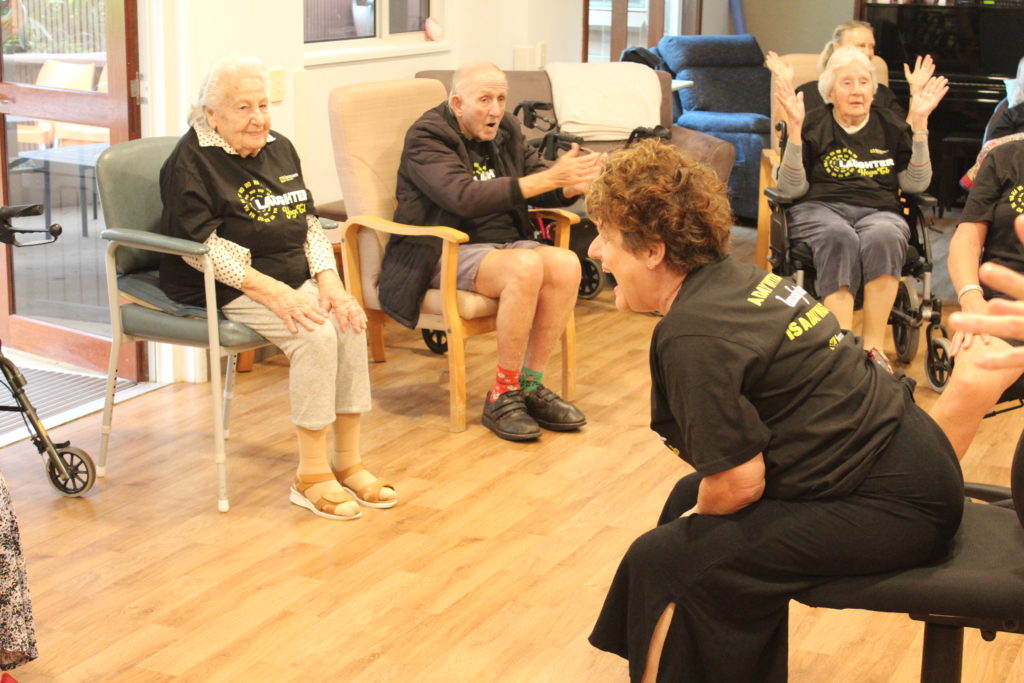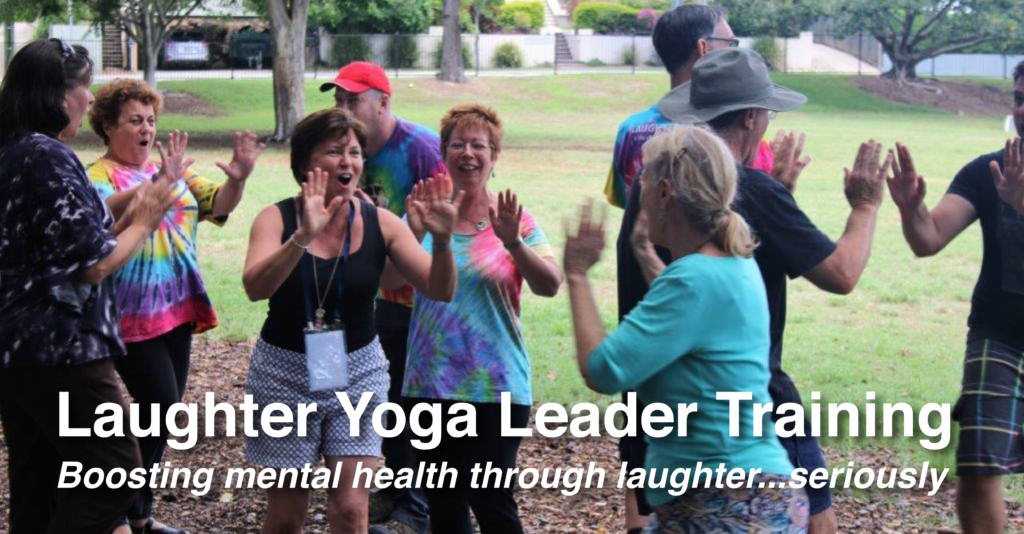
5 places you’d never expect to find laughter yoga
While laughter yoga has gained increasing acceptance as a proven stress management tool and team building activity in workplaces – and as a community connector for neighbourhood centres seeking to break down social isolation and boost life’s joy factor – it’s also making a difference in some unusual fields and settings.
It’s easy to laugh when we’re having a good time and in good company.
But imagine laughing loud and long while undergoing a life-sustaining medical intervention or being in a room with the last person on Earth you want to be near. It’s happening. Read on to find out where…
What is laughter yoga
Laughter yoga is a process that enables us to laugh even when we may not be feeling like it. In doing so, and in sustaining laughter beyond a moment’s titter, we tap into the body’s own cocktail of feelgood chemicals.
There’s no reliance on jokes or humour. Indeed laughter yoga is the world’s leading non-humour-based laughter therapy.
It’s usually considered a group practice (although the laughter exercises and mindful breath work can be done one-on-one). It’s often done in parks or recreation halls or yoga studios, and since COVID, online!
But these settings are very real and very different… Read on to find out where, how and why.
1. Family law – when mediation and counselling fail
A few years ago, a family court judge in the Indian city of Pune made a curious court order: she sent a warring couple to laughter yoga classes to help resolve what marriage counselling and mediation had failed to do.
Divorce can be incredibly stressful at so many levels – emotional, physical, mental, spiritual, financial, and social (I remember!).
This particular judge noted that four years of acrimonious proceedings had taken a toll on the couple and that it was in the interests of their child — as well as themselves — to be less anxious, angry, and stressed.
In its order, the court said:
“This nuanced exercise may motivate the litigating parties to discard the hurt, pain and worry and facilitate them to take an appropriate decision.”
Pune family court judge
If you’re working with past lovebirds who are now angrybirds, consider suggesting they try a laughter club experience online or in person – you’ll find locations here – or perhaps add laughter yoga leader skills to your own repertoire. Training dates for the 2-day workshops in Brisbane are at this link.
2. Dialysis clinics – a chance to exercise body, mind and spirits
Haemodialysis, as a treatment for kidney disease, forces hours and hours of physical inactivity while hooked up to a machine removing waste, chemicals and excess fluid from the blood.
Little wonder that research has found lower levels of life satisfaction and general wellbeing among haemodialysis patients compared to the general population.
But that’s changing in some progressive dialysis clinics in Australia and overseas.
Academic and nurse Dr Paul Bennett encourages ‘laughter therapy’ in the form of laughter yoga as a way to increase physical activity, open up the lungs, help patients relax, feel less pain, stress, and sadness, and connect with others. Take a look.
Laughter yoga leaders and/or nurses trained in laughter yoga deliver modified exercises that are jolly boredom busters.
Not surprisingly, Bennett found anxiety and stress lessened and general life satisfaction improved…and more.
There was no change in blood pressure after dialysis (a good thing), fewer episodes of low blood pressure during dialysis (another good thing), no change in lung function (another concern allayed) and no increase in cramps or needle issues. Very good very good yay.
Interested in learning how to take this skill into your clinic? Check out my training workshop dates.
3. Behind prison walls – breaking free
Mexican Luis Gomez has helped countless hardened criminals break free – of their anger and depression.
Working with psychologists and prison staff, Gomez has developed laughter yoga programs for rehabilitation.
The laughter exercises and mindful breathwork help resolve long-standing negative emotions and place inmates in a much more positive frame of mind. It’s helped with communication on the inside too.
As Gomez has explained, while prisons are noisy places, mindfulness skills learned through laughter yoga sessions help bring a sense of peace and quiet: “For a few minutes, they are out of there.”
Initial data has suggested lower recidivism rates among participants. It’s not been attempted in Queensland — or Australia, to my knowledge. Could you change that?
Soy Libre!
4. Dementia care – winding back
Dementia is a thief, a brain disease that gradually robs a person of their personality, their memory, their communication, judgement, reasoning, and movement.
Laughter yoga doesn’t require the cognitive skills of ‘getting’ a joke in order to laugh. Simple repeated laughter exercises elicit sounds of hohohahaha, there’s clapping or stomping, and smiling. It feels good.
For a person diagnosed with dementia, laughter yoga ticks quite a few boxes as a suitable exercise regimen:
- Laughter yoga is pleasurable — it’s a mood booster
- Laughter yoga keeps the body active — even seated, it’s like internal jogging
- Laughter yoga winds back stress — and there’s a lot of angst
- Laughter yoga boosts social contact and connection.
Published research from Japan noted improvement in deteriorating motor function of lips and tongue (important for speech and swallowing) as well.
In short, laughter yoga helps improve quality of life. Listen to how aged care providers Feros Care embraces laughter yoga in its wellbeing program for residents.
Little wonder more lifestyle officer, aged care workers and nurses are learning laughter yoga techniques or seeking out the practice’s inclusion in their group activities – not only in dementia care units but more broadly in aged care facilities. Laughter really is good medicine.
If you’d like to learn laughter yoga exercises and how to facilitate sessions for groups of people you work with, check out the training options here.
5. Building trust and resilience in communities torn apart
The tiny African nation of Rwanda is known for gorillas and genocide. The 1994 civil war saw open slaughter of as many as 800,000 men, women and children from the Tutu ethnic group.
The nation continues to heal – and laughter yoga is part of that healing. West Australian Kim O’Meara introduced laughter yoga there about a decade ago and it’s been embraced as a tool helping to rebuild community and individual confidence, connection and resilience, strengthening mental wellbeing to trauma.
In Rwanda, genocide survivors and former prisoners convicted of killing face off, smile, laugh, shake hands: hug. It’s taught in the schools too.
If you work in communities needing to build trust and resilience, laughter yoga leader training may be a skill to add to your toolkit.
Who does laughter yoga leader training
No prior experience of laughter yoga – or any yoga – is needed to do the 2-day certified laughter yoga leader training (although I recommend a lot of practice afterwards for your own benefit). Laughter yoga training participants come from many fields. They may be counsellors, psychologists, teachers, lifestyle coordinators, nurses, disability support workers, aged care support workers, team leaders, HR professionals, volunteer coordinators, and neighbourhood centre staff. This list is in no way definitive. If you can see a space and place for laughter yoga, make it happen!


